2003 LINCOLN BLACKWOOD air conditioning
[x] Cancel search: air conditioningPage 1 of 280

Introduction 4
Instrument Cluster 12
Warning and control lights 12
Gauges 16
Entertainment Systems 19
AM/FM stereo cassette 19
AM/FM stereo cassette with CD 25
AM/FM stereo with CD 28
Rear seat controls 35
Climate Controls 38
Manual heating and air conditioning 38
Electronic automatic temperature control 41
Rear window defroster 43
Lights 44
Headlamps 44
Turn signal control 46
Bulb replacement 48
Driver Controls 54
Windshield wiper/washer control 54
Power windows 60
Mirrors 61
Speed control (Cruise control) 63
Table of Contents
1
Page 39 of 280
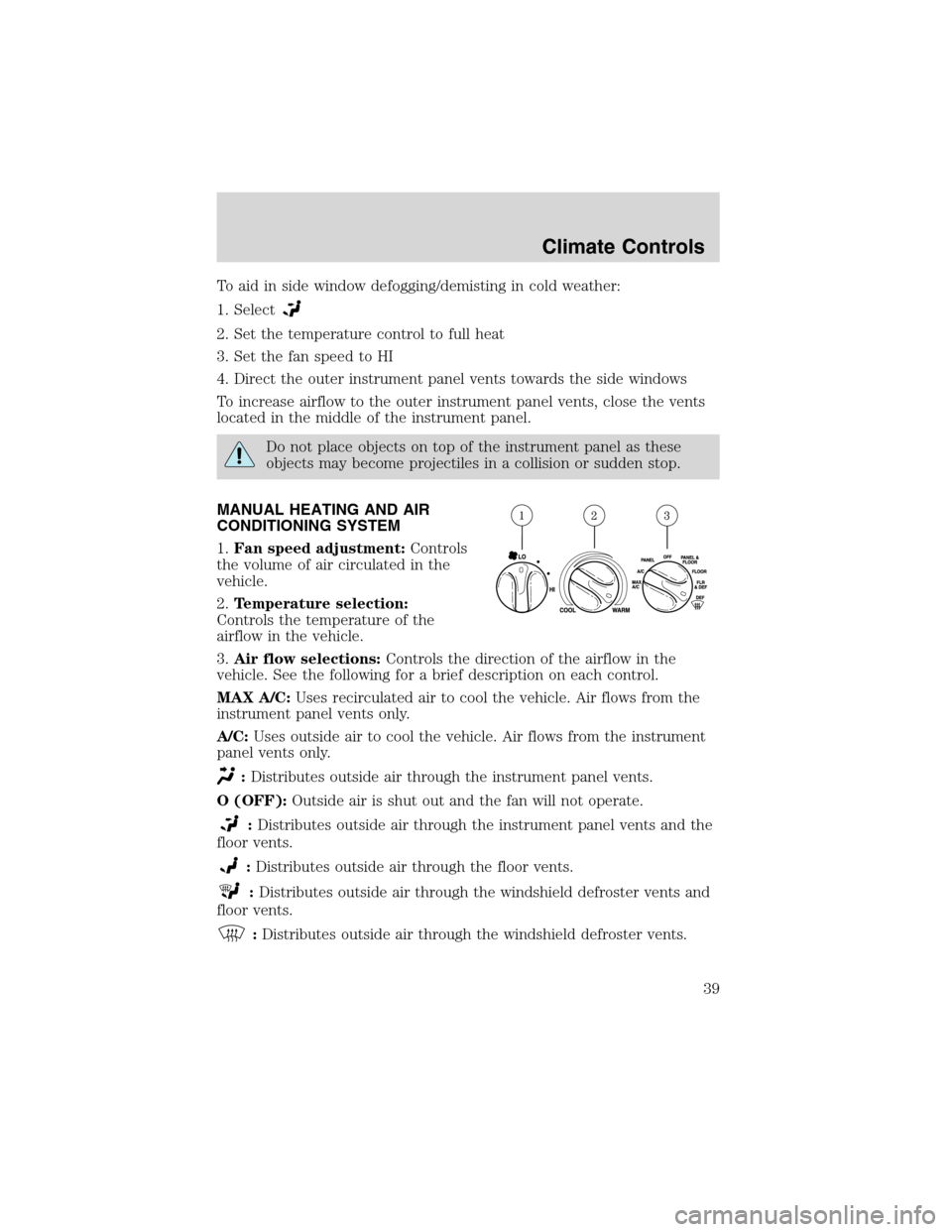
To aid in side window defogging/demisting in cold weather:
1. Select
2. Set the temperature control to full heat
3. Set the fan speed to HI
4. Direct the outer instrument panel vents towards the side windows
To increase airflow to the outer instrument panel vents, close the vents
located in the middle of the instrument panel.
Do not place objects on top of the instrument panel as these
objects may become projectiles in a collision or sudden stop.
MANUAL HEATING AND AIR
CONDITIONING SYSTEM
1.Fan speed adjustment:Controls
the volume of air circulated in the
vehicle.
2.Temperature selection:
Controls the temperature of the
airflow in the vehicle.
3.Air flow selections:Controls the direction of the airflow in the
vehicle. See the following for a brief description on each control.
MAX A/C:Uses recirculated air to cool the vehicle. Air flows from the
instrument panel vents only.
A/C:Uses outside air to cool the vehicle. Air flows from the instrument
panel vents only.
:Distributes outside air through the instrument panel vents.
O (OFF):Outside air is shut out and the fan will not operate.
:Distributes outside air through the instrument panel vents and the
floor vents.
:Distributes outside air through the floor vents.
:Distributes outside air through the windshield defroster vents and
floor vents.
:Distributes outside air through the windshield defroster vents.
Climate Controls
39
Page 140 of 280

Guarding against exhaust fumes
Carbon monoxide is present in exhaust fumes. Take precautions to avoid
its dangerous effects.
If you smell exhaust fumes inside your vehicle, have your dealer
inspect your vehicle immediately. Do not drive if you smell
exhaust fumes.
Important ventilating information
If the engine is idling while the vehicle is stopped for a long period of
time, open the windows at least 2.5 cm (one inch) or adjust the heating
or air conditioning to bring in fresh air.
BRAKES
Occasional brake noise is normal. If a metal-to-metal, continuous grinding
or continuous squeal sound is present, the brake linings may be worn-out
and should be inspected by a qualified service technician. If the vehicle
has continuous vibration or shudder in the steering wheel while braking,
the vehicle should be inspected by a qualified service technician.
Four-wheel anti-lock brake system (ABS)
Your vehicle is equipped with an Anti-lock Braking System (ABS). This
system helps you maintain steering control during emergency stops by
keeping the brakes from locking. Noise from the ABS pump motor and
brake pedal pulsation may be observed during ABS braking; any
pulsations or mechanical noise you may feel or hear is normal.
Using ABS
When hard braking is required, apply continuous force on the brake
pedal; do not pump the brake pedal since this will reduce the
effectiveness of the ABS and will increase your vehicle’s stopping
distance. The ABS will be activated immediately, allowing you to retain
full steering control during hard braking and on slippery surfaces.
However, the ABS does not decrease stopping distance.
ABS warning lamp
ABS
TheABSlamp in the instrument cluster momentarily illuminates when
the ignition is turned to ON. If the light does not illuminate during start
up, remains on or flashes, the ABS may be disabled and the ABS may
need to be serviced.
Driving
140
Page 232 of 280
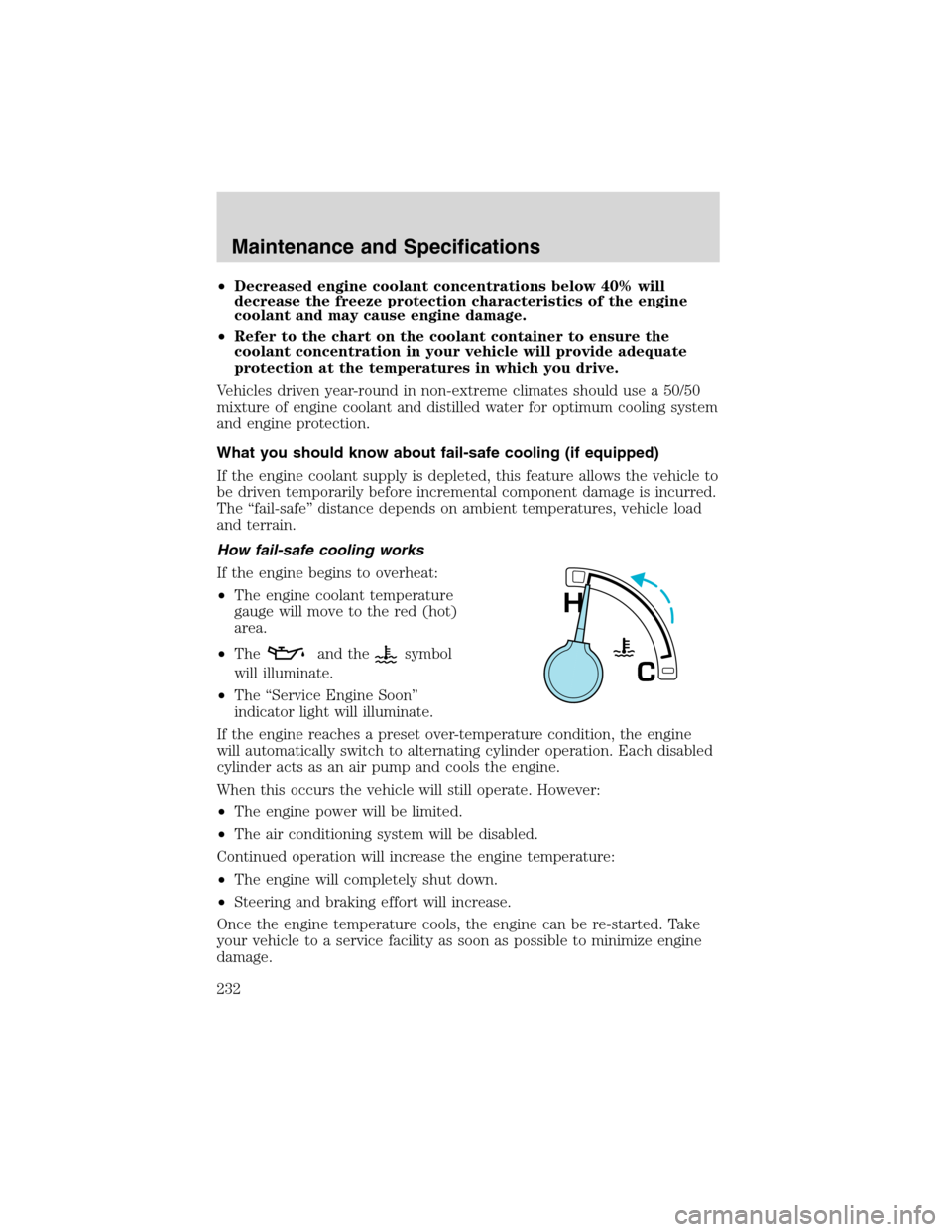
•Decreased engine coolant concentrations below 40% will
decrease the freeze protection characteristics of the engine
coolant and may cause engine damage.
•Refer to the chart on the coolant container to ensure the
coolant concentration in your vehicle will provide adequate
protection at the temperatures in which you drive.
Vehicles driven year-round in non-extreme climates should use a 50/50
mixture of engine coolant and distilled water for optimum cooling system
and engine protection.
What you should know about fail-safe cooling (if equipped)
If the engine coolant supply is depleted, this feature allows the vehicle to
be driven temporarily before incremental component damage is incurred.
The“fail-safe”distance depends on ambient temperatures, vehicle load
and terrain.
How fail-safe cooling works
If the engine begins to overheat:
•The engine coolant temperature
gauge will move to the red (hot)
area.
•The
and thesymbol
will illuminate.
•The“Service Engine Soon”
indicator light will illuminate.
If the engine reaches a preset over-temperature condition, the engine
will automatically switch to alternating cylinder operation. Each disabled
cylinder acts as an air pump and cools the engine.
When this occurs the vehicle will still operate. However:
•The engine power will be limited.
•The air conditioning system will be disabled.
Continued operation will increase the engine temperature:
•The engine will completely shut down.
•Steering and braking effort will increase.
Once the engine temperature cools, the engine can be re-started. Take
your vehicle to a service facility as soon as possible to minimize engine
damage.
C
H
Maintenance and Specifications
232
Page 273 of 280
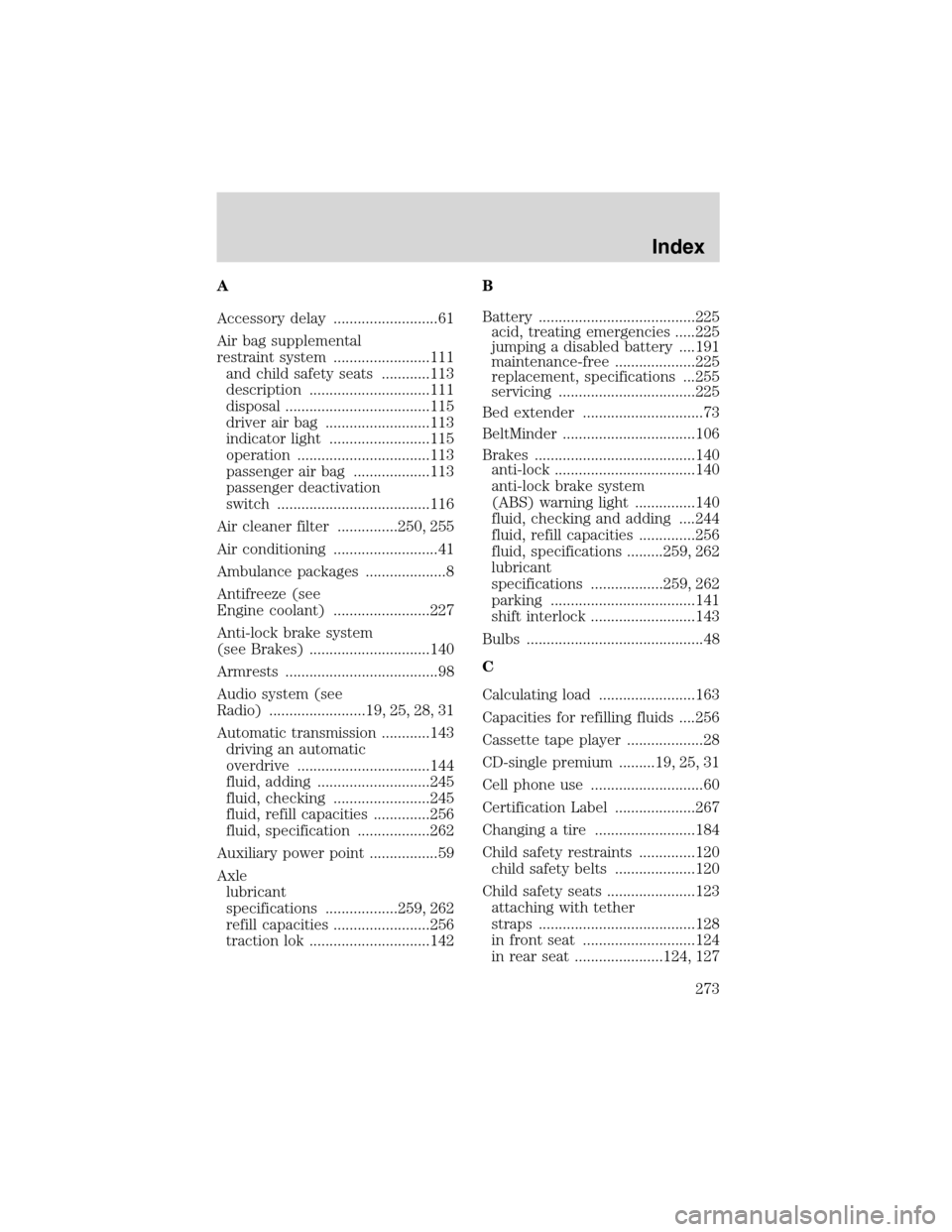
A
Accessory delay ..........................61
Air bag supplemental
restraint system ........................111
and child safety seats ............113
description ..............................111
disposal ....................................115
driver air bag ..........................113
indicator light .........................115
operation .................................113
passenger air bag ...................113
passenger deactivation
switch ......................................116
Air cleaner filter ...............250, 255
Air conditioning ..........................41
Ambulance packages ....................8
Antifreeze (see
Engine coolant) ........................227
Anti-lock brake system
(see Brakes) ..............................140
Armrests ......................................98
Audio system (see
Radio) ........................19, 25, 28, 31
Automatic transmission ............143
driving an automatic
overdrive .................................144
fluid, adding ............................245
fluid, checking ........................245
fluid, refill capacities ..............256
fluid, specification ..................262
Auxiliary power point .................59
Axle
lubricant
specifications ..................259, 262
refill capacities ........................256
traction lok ..............................142B
Battery .......................................225
acid, treating emergencies .....225
jumping a disabled battery ....191
maintenance-free ....................225
replacement, specifications ...255
servicing ..................................225
Bed extender ..............................73
BeltMinder .................................106
Brakes ........................................140
anti-lock ...................................140
anti-lock brake system
(ABS) warning light ...............140
fluid, checking and adding ....244
fluid, refill capacities ..............256
fluid, specifications .........259, 262
lubricant
specifications ..................259, 262
parking ....................................141
shift interlock ..........................143
Bulbs ............................................48
C
Calculating load ........................163
Capacities for refilling fluids ....256
Cassette tape player ...................28
CD-single premium .........19, 25, 31
Cell phone use ............................60
Certification Label ....................267
Changing a tire .........................184
Child safety restraints ..............120
child safety belts ....................120
Child safety seats ......................123
attaching with tether
straps .......................................128
in front seat ............................124
in rear seat ......................124, 127
Index
273
Page 274 of 280
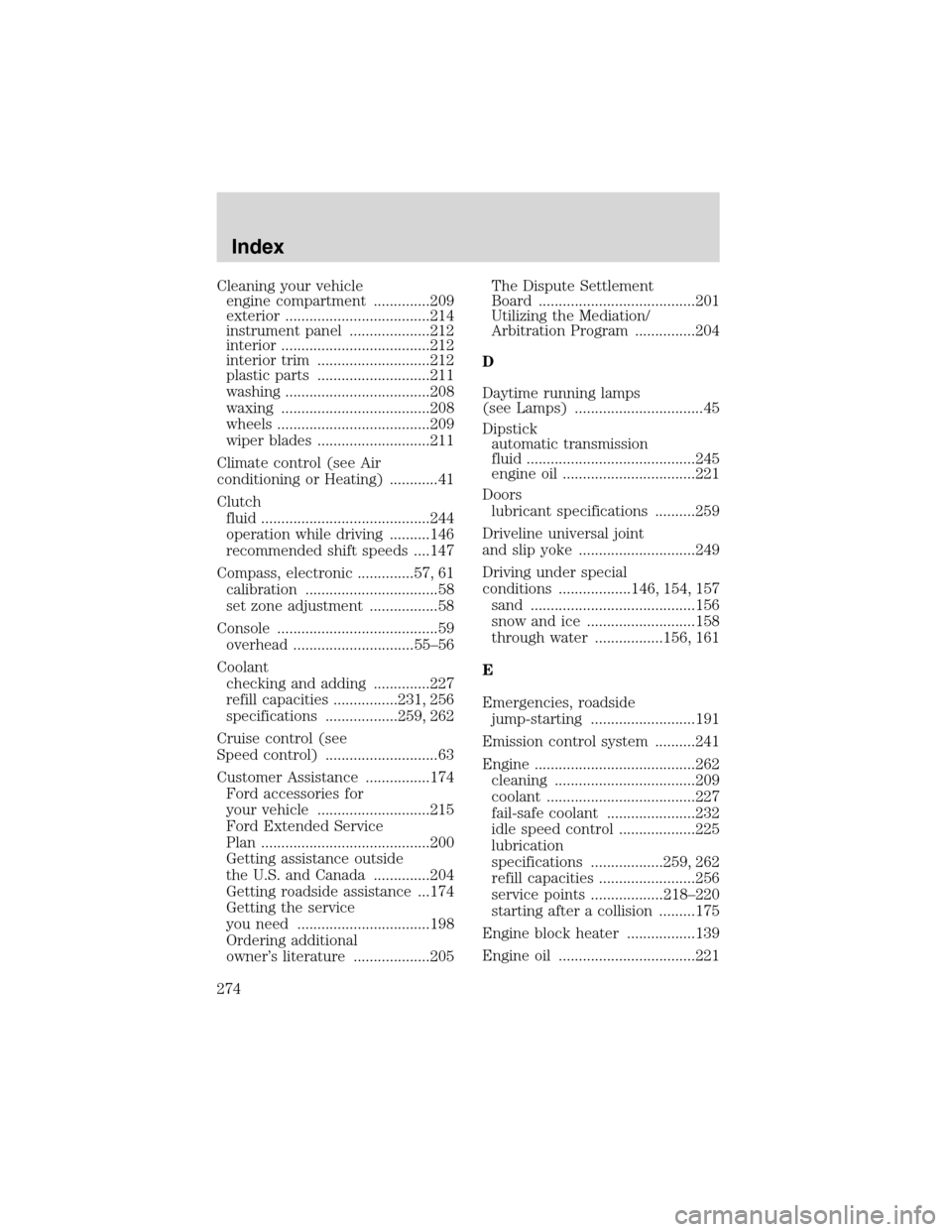
Cleaning your vehicle
engine compartment ..............209
exterior ....................................214
instrument panel ....................212
interior .....................................212
interior trim ............................212
plastic parts ............................211
washing ....................................208
waxing .....................................208
wheels ......................................209
wiper blades ............................211
Climate control (see Air
conditioning or Heating) ............41
Clutch
fluid ..........................................244
operation while driving ..........146
recommended shift speeds ....147
Compass, electronic ..............57, 61
calibration .................................58
set zone adjustment .................58
Console ........................................59
overhead ..............................55–56
Coolant
checking and adding ..............227
refill capacities ................231, 256
specifications ..................259, 262
Cruise control (see
Speed control) ............................63
Customer Assistance ................174
Ford accessories for
your vehicle ............................215
Ford Extended Service
Plan ..........................................200
Getting assistance outside
the U.S. and Canada ..............204
Getting roadside assistance ...174
Getting the service
you need .................................198
Ordering additional
owner’s literature ...................205The Dispute Settlement
Board .......................................201
Utilizing the Mediation/
Arbitration Program ...............204
D
Daytime running lamps
(see Lamps) ................................45
Dipstick
automatic transmission
fluid ..........................................245
engine oil .................................221
Doors
lubricant specifications ..........259
Driveline universal joint
and slip yoke .............................249
Driving under special
conditions ..................146, 154, 157
sand .........................................156
snow and ice ...........................158
through water .................156, 161
E
Emergencies, roadside
jump-starting ..........................191
Emission control system ..........241
Engine ........................................262
cleaning ...................................209
coolant .....................................227
fail-safe coolant ......................232
idle speed control ...................225
lubrication
specifications ..................259, 262
refill capacities ........................256
service points ..................218–220
starting after a collision .........175
Engine block heater .................139
Engine oil ..................................221
Index
274
Page 275 of 280
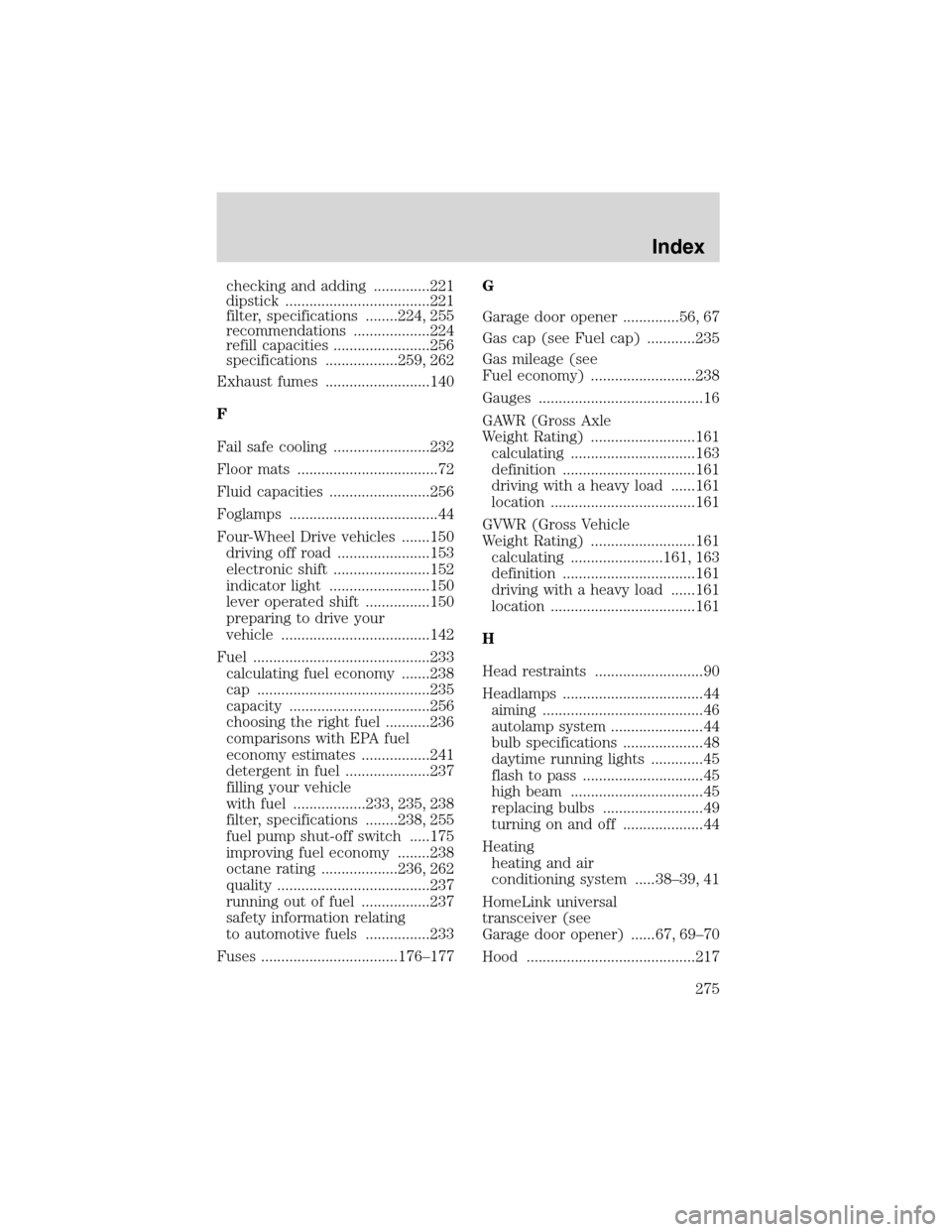
checking and adding ..............221
dipstick ....................................221
filter, specifications ........224, 255
recommendations ...................224
refill capacities ........................256
specifications ..................259, 262
Exhaust fumes ..........................140
F
Fail safe cooling ........................232
Floor mats ...................................72
Fluid capacities .........................256
Foglamps .....................................44
Four-Wheel Drive vehicles .......150
driving off road .......................153
electronic shift ........................152
indicator light .........................150
lever operated shift ................150
preparing to drive your
vehicle .....................................142
Fuel ............................................233
calculating fuel economy .......238
cap ...........................................235
capacity ...................................256
choosing the right fuel ...........236
comparisons with EPA fuel
economy estimates .................241
detergent in fuel .....................237
filling your vehicle
with fuel ..................233, 235, 238
filter, specifications ........238, 255
fuel pump shut-off switch .....175
improving fuel economy ........238
octane rating ...................236, 262
quality ......................................237
running out of fuel .................237
safety information relating
to automotive fuels ................233
Fuses ..................................176–177G
Garage door opener ..............56, 67
Gas cap (see Fuel cap) ............235
Gas mileage (see
Fuel economy) ..........................238
Gauges .........................................16
GAWR (Gross Axle
Weight Rating) ..........................161
calculating ...............................163
definition .................................161
driving with a heavy load ......161
location ....................................161
GVWR (Gross Vehicle
Weight Rating) ..........................161
calculating .......................161, 163
definition .................................161
driving with a heavy load ......161
location ....................................161
H
Head restraints ...........................90
Headlamps ...................................44
aiming ........................................46
autolamp system .......................44
bulb specifications ....................48
daytime running lights .............45
flash to pass ..............................45
high beam .................................45
replacing bulbs .........................49
turning on and off ....................44
Heating
heating and air
conditioning system .....38–39, 41
HomeLink universal
transceiver (see
Garage door opener) ......67, 69–70
Hood ..........................................217
Index
275